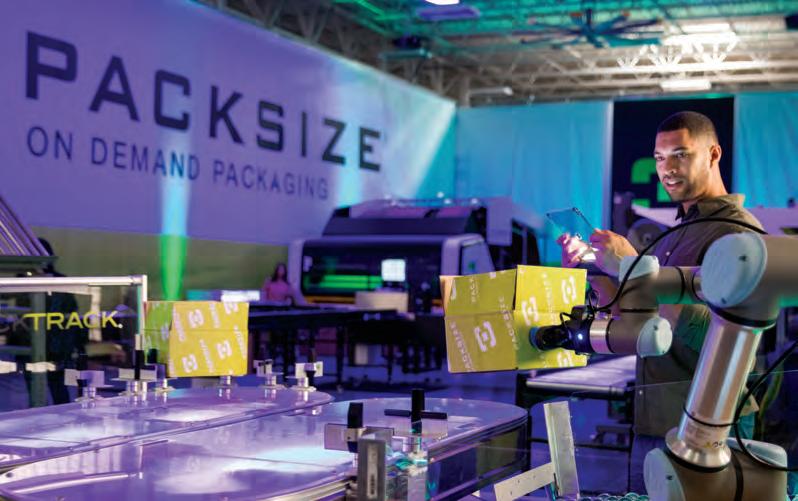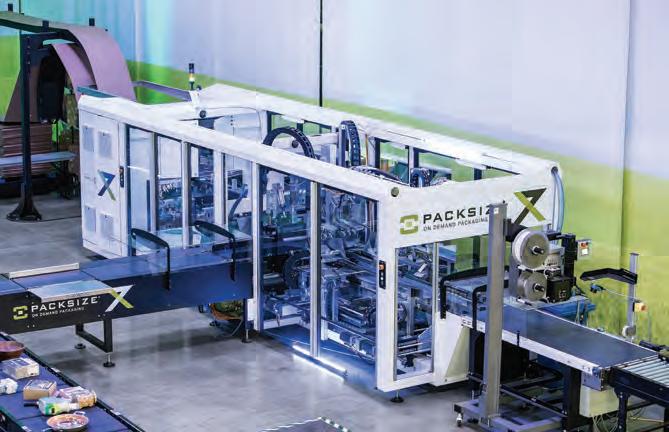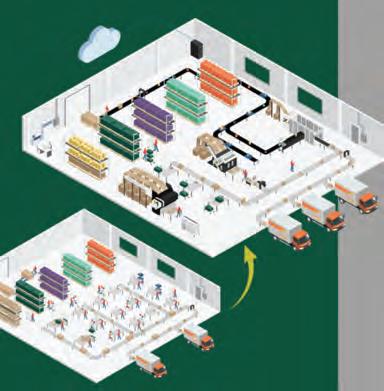
4 minute read
Packaging automation: When to
PACKAGING AUTOMATION: WHEN TO MAKE THE SWITCH
As many businesses adjust to an increase in online sales from the e-commerce boom – labour, speed and productivity issues are forcing the hand of many into automation of their packaging process. Sean Ledbury, Managing Director of Packsize Australia explains how to determine the level of automation versus integration.
Across all industries, companies are recognising that it is now necessary to adopt new packaging optimisation tools, and materials and handling technologies that will boost efficiency, productivity, and sustainability.
Sean Ledbury, Managing Director of Packsize Australia says the On Demand Packaging™ machines are equipped for use across a wide variety of industries and can be integrated into an existing production line or stand alone, depending on the unique packaging requirements. Once you make the switch to automated packaging, he says, the difference will be noticed instantaneously.
INDICATIONS FOR STARTING AUTOMATION
INCREASED DEMAND
If companies are expecting growth in the markets they serve, or anticipate adding products in the coming year, then automation is a smart investment, says Sean. A pre-configured packaging system designed for your unique environment can maximise your entire workflow and potentially increase output by 20-30 per cent.
SHIPPING MULTIPLE PRODUCTS
If you are shipping several different types of orders in varying shapes and sizes, this can take up large amounts of time on the warehouse floor. Automation drastically cuts down labour spent on packaging products and time-costly change overs. By designing right-sized boxes in any shape or size, an integrated packaging system reduces the number of packing stations, resulting in increased line efficiency and overall productivity.
Accessing Packsize integrated technologies leads to overall productivity enhancements.
LABOUR ISSUES
The labour force is often the first area to show signs of strain in a fastpaced warehouse environment. If your packaging team is not able to keep up, you are experiencing increases in work-related injuries, a high labour turnover rate, or find your labour force doubling in size during peak seasons, it’s time to review options in automation. Packaging automation can handle everyday demands and seasonal surges, while significantly reducing labour costs. Within months of implementing On Demand Packaging systems, Packsize customers reported significant savings in labour costs, and a 20-30 per cent reduction in employee training. A leading retailer and Packsize customer reduced its workforce by 11 full-time employees during the holiday season after streamlining its packaging operations through automation.
EIGHT FEATURES OF A TOTAL PACKING SOLUTION
To design a custom packaging solution, it’s important to determine your packaging needs and enlist an automated packaging professional to help develop a streamlined process that meets your unique operational
Packsize X7 machine, automatically erects a box around a completed order in seconds.
requirements. Utilising automated processes in a packaging operation can greatly increase packaging efficiency through increased throughput. On Demand Packaging systems deliver customised solutions that integrate with one or more of the following eight features that occur in every packaging process.

1. DATA INTEGRATION
When a purchase order generates work to be done, the data must be understood and translated for the rest of the process to work. An integrated software platform can be customized to provide this framework.
The Packsize PackNet™ software platform automatically calculates the best box style and packaging for each shipment with automated dimension capture and WMS integration.
2. PRODUCT TRANSPORT
To efficiently transport a product from point A to point B in the packaging process, the product must be routed to be packed or sorted for shipping.
With Right-sized Packaging on Demand™ products can be transported by both conveyor and by cart.
3. CARTON PRODUCTION
Creating right-sized boxes produces substantial savings in warehouse space, labour, and shipping. There are various automated packaging systems available to make a variety of right-sized designs.
4. PRODUCT PROTECTION
By creating a right-sized box, products are not moving around inside the box, resulting in less damage during transit. Depending on product size, shape, and fragility, Packsize packaging experts can advise if additional product protection is required. Assessing your current packaging operation is critical in identifying where productivity issues may occur and assisting in determining needed process improvements. ”
5. CARTON ERECT
Erecting a box can be performed by hand or by machine. Packsize offers a variety of systems to provide full or partial automation depending on each unique packaging environment.
The Packsize X4™ offers partial automation with human assistance, while the Packsize X7 automatically erects a box around a completed order in seconds.
6. ID / MARKING
Most cartons need to be identified or marked with bar codes, labels, or print.
7. SORTATION
Packages can be automatically sorted by purchase order, customer, or destination and placed on specific pallets or into assigned trucks.
8. BUSINESS INTELLIGENCE
Gathering accurate analytical data is important to review productivity and make future improvements.
PackNet software provides the necessary level of business logic and framework to accomplish On Demand Packaging functionality, such as the ability to prioritise box production, meet workflows, manage multiple machines, and create insightful reports.
“It’s clear that using automated machine systems can increase packing efficiency while cutting costs through both waste and damage reduction,” Sean says.
“Assessing your current packaging operation is critical in identifying where productivity issues may occur and assisting in determining needed process improvements.” ■











